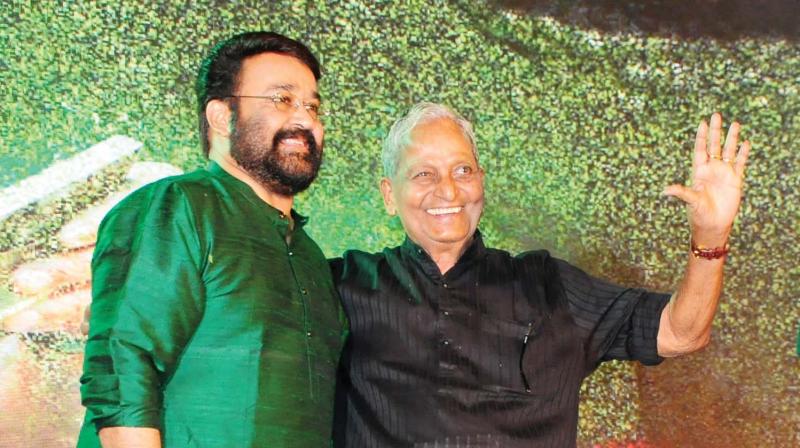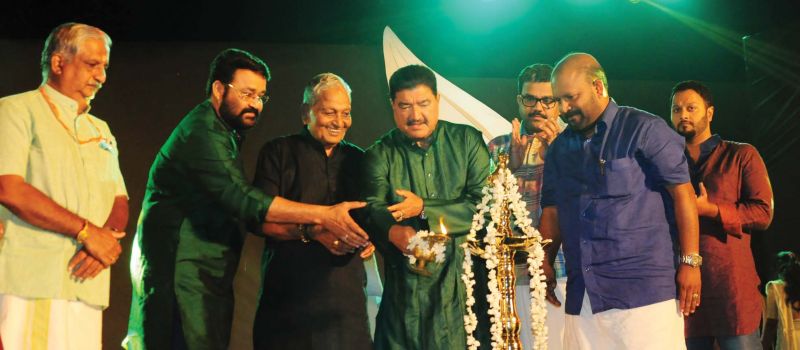Modernist in ancient's garb

Kalamandalm Gopi, in a sense, is a miracle man, a man who united the past and the present, the then and the now. He contemporized an art form that was deeply rooted in tenacious traditions and conventions, without compromising, even in the least, the rigours of its craft. There is a general misconception that classical art forms are resistant to change and that their styles and systems are fixed, unchanging, and almost in a state of permanence. Such notions arise primarily from a superficial appreciation that takes into consideration merely the external forms of such arts, and are aided by the idea that these art forms essentially belong to the past, and so are in a state of suspended animation. However, with a more discerning perspective, it will become apparent that such auras of permanence can be thoroughly misleading, because in their latent forms, in their internal dynamics, these art forms are constantly undergoing change. One requires an incisive kind of historical understanding to locate such subtle, and sometimes imperceptible, internal transformations. It may also do us well to realize that the artistes involved in classical forms - whether performers or musicians - are not vestiges of the past or characters in a period drama.
They live in the 'today' like us, and are subject to all the turbulences of contemporary life. Their experiences cannot but have an effect on their existence as art practitioners, and on their very practice of the art form. There also comes a time when these experiences can accumulate historically and achieve a sort of critical mass that can set in motion momentous transformations that can redefine the very identity and nature of the art form. Looking back on the history of Kathakali, it becomes evident that it went through such a transformation around the middle of the last century when a series of changes effectively ushered a culture of modernity into the practices of the form, in both its performative and pedagogic aspects. To a great extent, it was the work of Pattikkamthodi Ravunni Menon that was at the centre of this transformation. On the one hand, he formulated a systematic pedagogy - 'kalari chitta' - that focused on instituting an embodied knowledge in Kathakali trainees that restructured their bodies as performative ones fully suitable for the bodily language and grammar of Kathakali. On the other, he evolved a different kind of performance aesthetic based upon the idea of character and propriety, wherein each major character in the Kathakali repertoire was conceived as being governed by a predominant emotion or 'sthayi bhava', and the nature of all his actions was principally determined by this primary emotion.
The importance of this aesthetic is precisely in that it injected a modern, individual ethos into the classical culture of Kathakali. It also led to a rigorous editing of the performance practices of the form, where all that does not tally with this overriding sense of character propriety - whether it be the dance segments, or the modes of rendering the gestures, or situational responses - came to be edited out of the performance, thereby instituting a harmonious totality and sense of beauty to the performance. It was this system that came to be known as the Kalluvazhi Chitta and came to be institutionalized through Kalamandalam. Stalwarts like Kalamandalam Ramakutty Nair, Kalamandalam Padmanbhan Nair, Kalamandalam Krishnan Nair, Kalamandalam Kumaran Nair, and Vazhayenkada Kunju Nair were the products of this style.. Kalamandalam Gopi, as a disciple of Padmanbhan Nair and Ramakutty Nair, represents not only the next generation but also the next higher stage in Kathakali's process of modernity, where the expressiveness of the form attains new and contemporary dimensions. Firmly rooted in the rigorous systems of the Kalluvazhi Chitta, Gopi is a consummate master at the portrayals of such central characters as Dharmaputra, Bhima, and Arjuna of the Kottayam plays that comprise the essential core of the Kathakali repertoire. At the same time, his foremost contribution is his portrayals of the other major characters of the Kathakali stage, such as Nala, Karna, and Rugmangada, as individuals caught in the throes of internal conflicts and self-questionings.
In a sense, it may be said that what Gopi has achieved is not only a crucial expansion of the Kalluvazhi Chitta to encompass such 'modern' introspective characters, but also to locate the performative discourse of Kathakali in a cultural mileu where the primary quandaries are those of the individual and of persistent self-doubts and self-questionings. With Gopi, Kathakali started to address some fundamental questions that the individual in the contemporary world was constrained to confront in his life. In other words, even while maintaining the rigours of Kalluvazhi Chitta, Gopi moulded the language of Kathakali to express what can be called an individual experience ridden with emotions, conflicts and crises. Gopi made kathakali contemporary, making it accessible to all kinds of people, for the novice and the connoisseur alike. It is then least surprising that for large sections of the audience, when Gopi's Nala and Karna posed such questions as "Who am I?" "Where do I come from?" "What is right and what is wrong?" "What is the meaning of life?", they felt one with him, and even as he was heavily clad in the conventional costumes and make-up of the form, they saw the quintessential human in him.
It is also a fact that Gopi's performances many a time creatively extends the language of Kathakali to build a continuity between it and contemporary visual culture. Even as there are several examples for such enedeavours, probably the most impressive one is Gopi's practice of turning away from his fellow actor/character at moments of heightened emotional intensity, and offering a profile of his face to the audience. Even as such a pose is completely foreign to the established systems of Kathakali acting, for an audience trained in the visual language of cinema, it would make immediate sense as a striking image of introspection and emotional crisis. Far from being the imitation of a cinematic language, what Gopi achieves here is a blending of the language of Kathakali and that of contemporary visual culture, thereby opening a door of transparent access to contemporary audiences. It may be safely said that in Kalamandalam Gopi, we see one of those rare instances where the content of the stage and the content of contemporary life seem to become one. What Gopi has achieved in his performative life is a historical coming together of two seemingly disparate things; the content of Kathakali and the content of contemporary life. The secret of Gopi's appeal lies in his ability to make the conflicts of the age old puranas feel immediate, of the here and the now.
A star-studded birthday bash
Actor Mohanlal and Abu Dhabi-based tycoon B. R. Shetty, who is the producer of his Rs 1,000-crore Mahabharata, on Saturday attended the Haritham cultural programme held here as a part of the 80th birthday celebrations of Kathakali maestro Kalamandalam Gopi.To participate in the function held at Lulu Conventional Hall, Mohanlal flew down breaking his busy shooting schedule in Thiruvananthapuram on a private chopper. The star said for him, Kathakali was a spiritual art form, and his close association with Gopi Asan began during the filming of Vanaprastham in which Mohanlal played the role of a Kathakali artist, and Gopi Asan, his father-in-law.
 Actor Mohanlal, industrialist B.R. Shetty and Kalamandalam Gopi light the traditional lamp to start the birthday celebrations. Melam maestro Peruvanam Kuttan Marar, agriculture minister V.S. Sunil Kumar are also seen. (Photo: DC)
Actor Mohanlal, industrialist B.R. Shetty and Kalamandalam Gopi light the traditional lamp to start the birthday celebrations. Melam maestro Peruvanam Kuttan Marar, agriculture minister V.S. Sunil Kumar are also seen. (Photo: DC)
"The presence of Gopi Asan in the film was a motivation for me, as I didn't know much about Kathakali to perform with confidence. For me, Gopi Asan means Kathakali and Kathakali, Gopi Asan," the actor said about the veteran who has been performing the art form for the past 60 years. Mr Shetty who had associated with the veteran by organising his shows in Abu Dhabi for the past six years said Kalamandalam Gopi and Mohanlal were like brothers to him. He said the outlay for Mahabharata when it was proposed to him was Rs 750 crore, but he wanted it to be a Rs 1,000-crore film. "The formal announcement regarding the movie will be held in Abu Dhabi on Sunday," said Mr Shetty. The maestro performed Navarasas and a Padham from the Kathakali Bahukan Mariman Kanni for the audience. Melam maestro Peruvanam Kuttan Marar and agriculture minister V.S. Sunil Kumar were also present.

